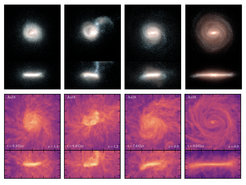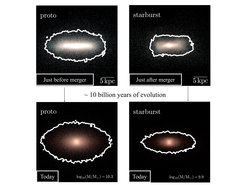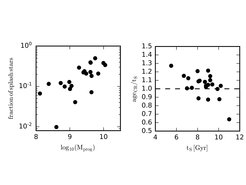Stellar clues reveal properties of significant merger in the young Milky Way’s history

Fig. 1: Thumbnail gallery of the stellar light (top panels) and gas density (bottom panels) of a simulated Milky Way analogue immediately before (first panel), during (second panel), immediately after (third panel) the Gaia-Enceladus merger, and at present day (fourth panel). The merging galaxy brings a lot of gas that fuels a burst in star formation beginning along a bridge of gas connecting it to the Milky Way.
The chronicle of the Milky Way is written in starlight: the history of our Galaxy can be deciphered from observing its stars and characterising their properties. For example, stars tend to be born on circular orbits around the Galactic centre, but over time they can begin to orbit on more oval, elongated trajectories, especially under the gravitational strains imposed during a galaxy merger, which may itself provide its own stars on near-radial orbits. In 2018, astronomers analysed the positions and velocities of stars observed by the Gaia satellite and discovered that the Milky Way had experienced a significant merger (Gaia-Enceladus) in its distant past. Stars that belonged to this merger were clearly identified to be on very radial (eccentric) orbits and make up a significant portion of the stellar halo - the faint light surrounding galaxies that constitutes the stellar garbage of debris from previously destroyed galaxies.
What was the Milky Way like before this cataclysmic event and how did it change?

Fig. 2: Left: Edge-on images of the simulated Milky Way’s proto-disc stars just before the merger event around 10 billion years ago (top) and at present day (bottom), depicting how disc stars are being scattered into the stellar halo as a result of the merger.
Right: Images of stars formed during the merger-induced starburst immediately after the merger (top) and at present day (bottom), illustrating that these stars are flatter and “diskier” compared to the proto-disc.
This question can only be answered with the help of simulations. Researchers at MPA have played a leading role in developing the Auriga simulations - the largest suite of simulations for the formation of the Milky Way in our Universe that model physical processes such as star formation, supernovae, black holes and magnetic fields. These tools provide powerful insights by offering a realtime look at the formation and evolution of galaxies, akin to watching a film that starts just after the Big Bang and ends at present day.
MPA scientists analysed these sophisticated simulations and found that about a third of the “Milky Way analogues” produced the Gaia-Enceladus feature in their stellar halo (see also the January Highlight for how MPA researchers revealed how this event shaped the Milky Way’s central stellar bar). In each case, this was linked to a significant merger in the Galaxy’s youth (Fig. 1). They found that the mergers had 2 significant effects: i) the merging galaxies were always “gas-rich”, bringing in a lot of fresh, star-forming material that instigated a powerful burst of star formation; and ii) the Milky Way’s “proto disc” - the dominant component of its adolescence - suffered serious damage from the impact, losing a hefty fraction of its mass as stellar orbits were “splashed” out of the disc toward the edges of the visible stellar halo (Fig. 2). Nevertheless, some of the proto-disc survived, and, together with the stars formed during the burst of star formation, constitute what astronomers call the “thick disc” - one of the Galaxy’s most significant components today.
Dating and weighing the Gaia-Enceladus merger

Thanks to the large suite of simulations, it was possible for the researchers to measure the impact of many “analogue mergers” with a range of masses and merger times. A key diagnostic is the fraction of stars orbiting the Galaxy in the direction opposite to the bulk rotation - stars that have been “splashed out” of the proto-disc because of the strong gravitational perturbation of the merger. Scientists found that more massive mergers lead to a higher fraction of these counter-rotating “splash” stars and that the ages of these stars are an accurate predictor for the time of the merger (Fig. 3).
Importantly, these results highlight that with an accurate census of counter-rotating stars and precise stellar ages in the real Milky Way, astronomers can place tight limits on key properties of this event. Comparing with recent Milky Way observations, these latest results point to a Gaia-Enceladus merger with a mass of about a billions Suns that merged roughly 10 billion years ago. In the future, more expansive observations and simulations will help us understand one of the biggest chapters in our cosmic history in tantalising detail.














